Download Practice Workbook
Overview of OFFSET Function
The OFFSET function returns a reference to a range that is a given number of rows & columns from a given reference. The function starts with a cell reference, moves to a specific number of rows down, then to a specific number of columns right, and extracts a section out of the data set.
It returns a section of data with a specific height and width, situated at a specific number of rows down and a specific number of columns right from a given cell reference.
The function will move the specified number of rows upward from the reference cell if the rows argument is negative.
The Syntax of the OFFSET function is:
=OFFSET(reference,rows,cols,[height],[width])
Reference indicates the cell reference from where it starts off moving.
Rows dictate the number of rows it moves downward.
Cols illustrate the number of columns it moves rightward.
Height indicates the number of rows of the section of the data that it extracts.
And width indicates the number of columns of the section of the data that it extracts.
7 Suitable Examples of OFFSET Function Using Excel Formulas
Example 1 – Extracting a Whole Row
Steps:
- Enter the following formula to extract the sales records for laptop for all the months.
=OFFSET(B5,7,0,1,6)
The OFFSET function starts moving from cell B5. It moves 7 rows downward to find the laptop. And extracts out a section of 1-row height and 6 columns of width. This is the sales record of laptop from Jan to May.
- Press Enter.
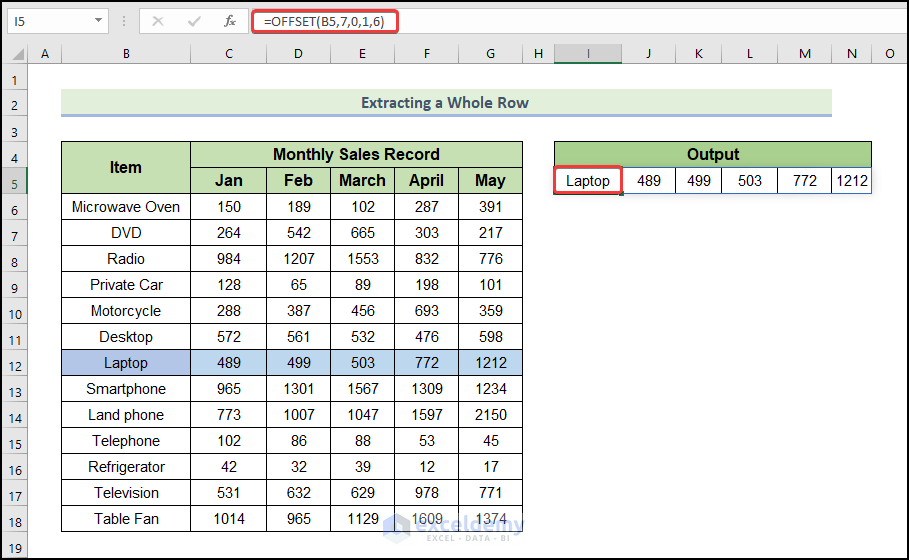
Read More: How to Use ROW Function in Excel (With 8 Examples)
Example 2 – Extracting an Entire Column
We’ll sort out a whole column from the dataset. Let’s try to find out all the sales in March. And we will extract a list of a total of 13 products.
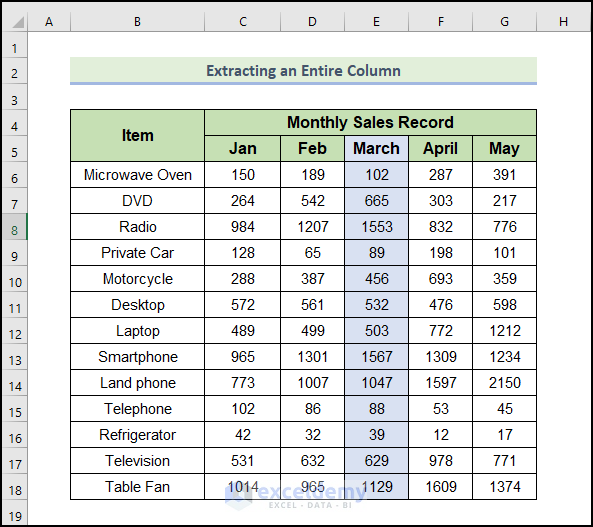
Steps:
- Enter the following formula.
=OFFSET(B5,0,3,13,1)
The function starts moving from cell B5. Moves 1 row down. It moves 3 columns right to the month of March and extracts a section of 13 rows in height (all the products) and 1 column in width (only for the month of March).
- Press Enter.
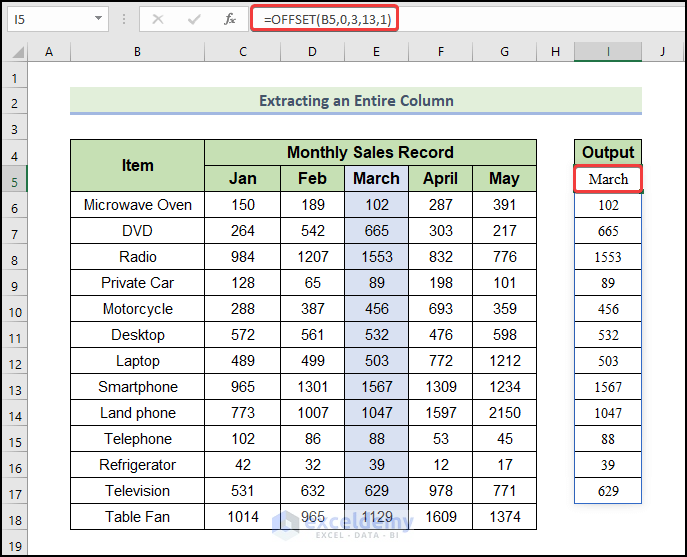
Example 3 – Extracting Adjacent Multiple Rows and Columns
Collect the sales of the products Mototorcyle, Desktop, and Laptop in the months of January and February.
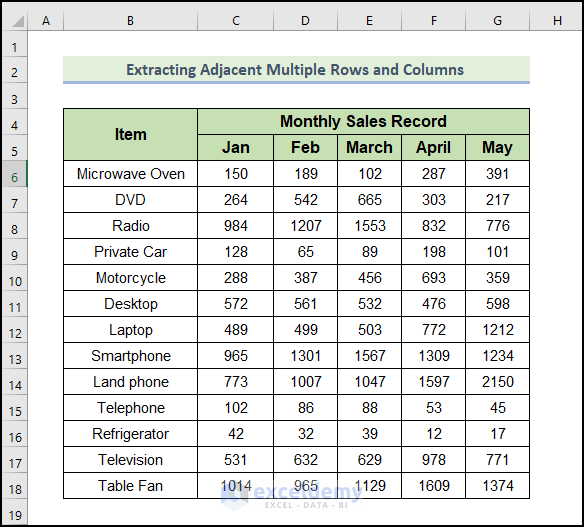
Steps:
- Enter the following formula.
=OFFSET(B5,5,0,3,3)
The function starts moving from cell B5. It moves 5 rows down to the product telephone. And collects the data of 3 rows height.
- Press Enter.
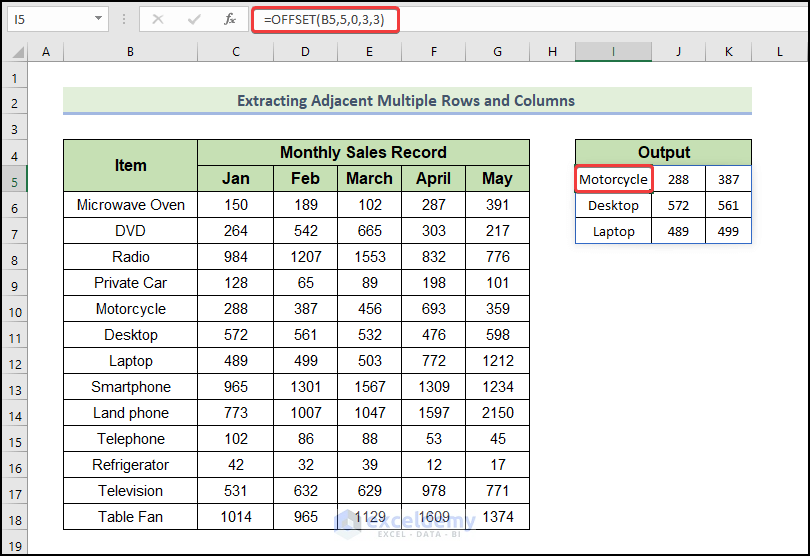
Read More: How to Use ROWS Function in Excel (With 7 Easy Examples)
Example 4 – Combining OFFSET & COUNTA Functions to Create Dynamic Range
COUNTA function counts the number of cells excluding all empty cells in a range of cells. Using COUNTA functions, we’ll assign the row height & column width based on the available data in the range.
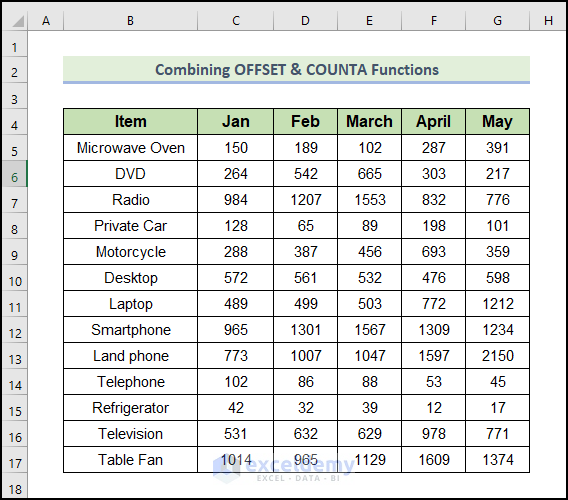
Steps:
- Enter the following formula.
=OFFSET(B4,0,0,COUNTA(B4:B100),COUNTA(B4:G4))
Row height has been assigned with COUNTA(B4:B100) in the argument section, which means that each row in the spreadsheet is assigned up to the 100th row. This way, whenever a new value is entered under the original range of data within the 100th row, that value will also be stored using the OFFSET function. COUNTA(B4:G4) has been defined as the column width, so the six columns (B, C, D, E, F and G) are now assigned to the function based on the reference value selected in the OFFSET function.
- Press Enter.
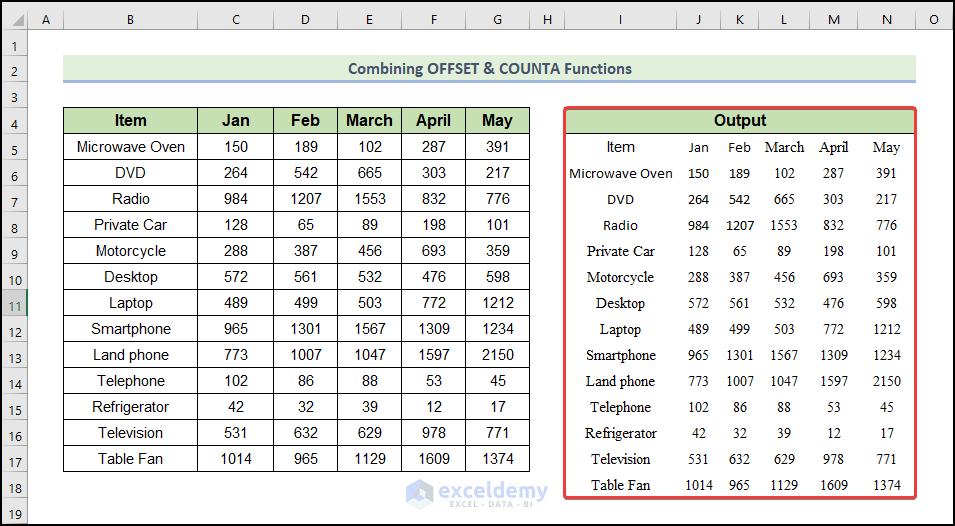
Example 5 – Creating Dynamic Range Using Name Manager with OFFSET Function
By using Name Manager, you can set the name of the resultant array found by the OFFSET function.
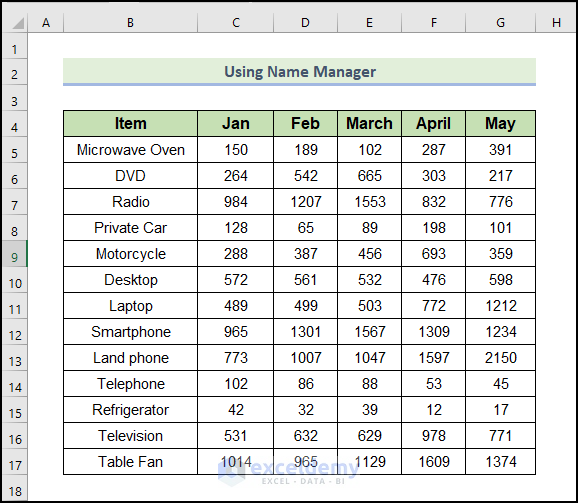
Steps:
- Under the Formula tab, select Name Manager.
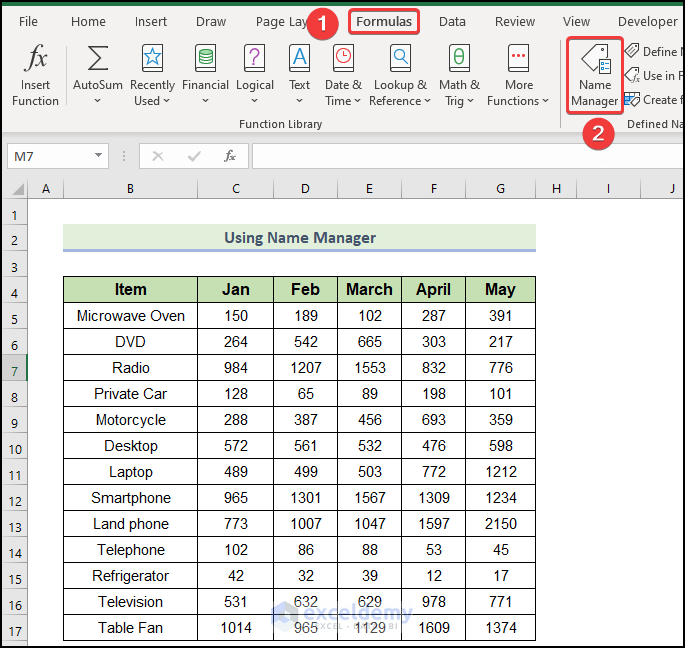
- A dialogue box will open.
- Press New.
- The Name Editor box will appear.
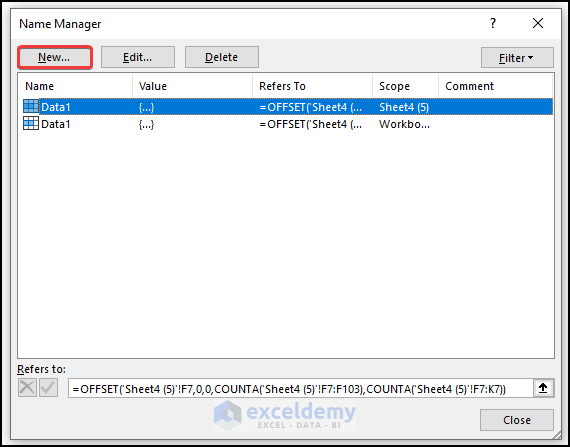
- Define the name of your dataset or the range of cells you want to offset.
- In the reference box, enter the following formula:
=OFFSET(B4,0,0,COUNTA(B4:B100),COUNTA(B4:G4))
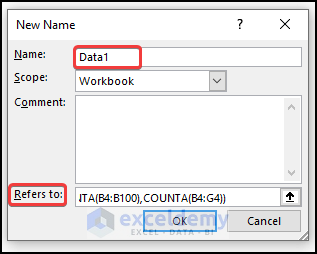
- Press OK & Name Manager will now show the defined name in the list along with the reference formula at the bottom.
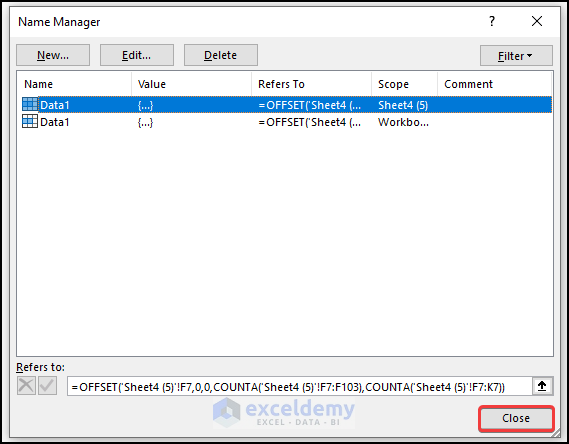
- Select any cell in your spreadsheet & enter the defined name as the formula. You’ll find the defined name in the function list.
- Select that function & press Enter.
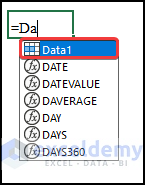
- The output will look like this.
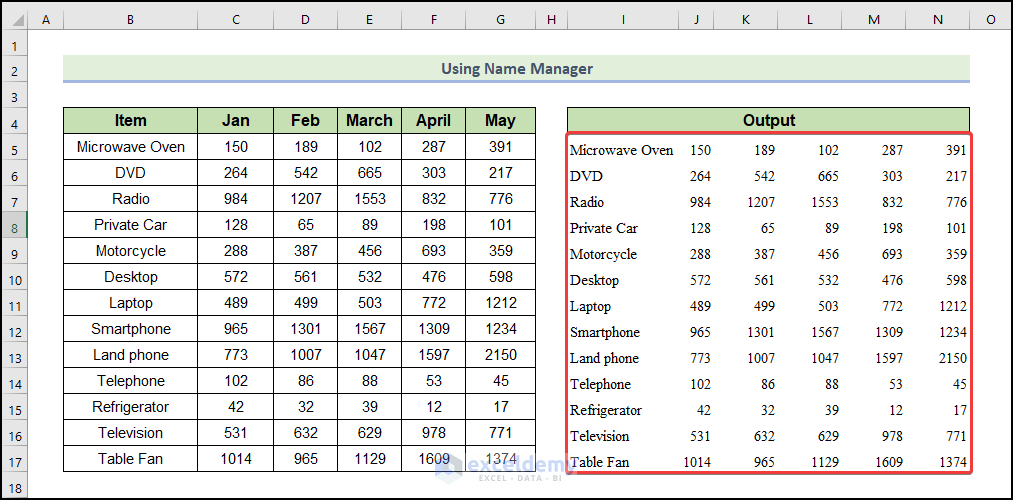
Example 6 – Getting Summation of an Entire Column
Steps:
- Enter the following formula in cell J5.
=SUM(OFFSET(F5,1,-2,13))
- Press Enter.
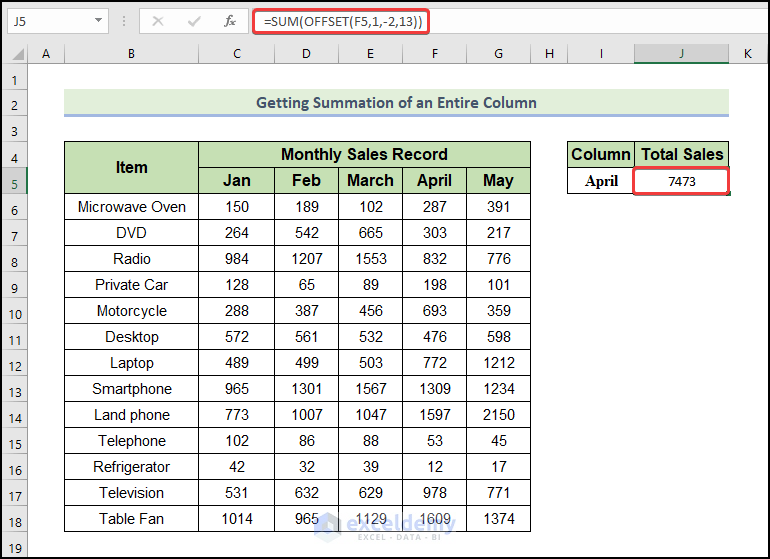
How Does the Formula Work?
- OFFSET(F5,1,-2,13)
The OFFSET function starts moving from cell F5. It moves 1 rows downward extracts the records of sales of the April column.
- SUM(OFFSET(F5,1,-2,13))
The OFFSET function’s output will be summed by the SUM function.
Example 7 – Getting Average of Whole Column
Steps:
- Enter the following formula in cell J5.
=AVERAGE(OFFSET(F5,1,-2,13))
- Press Enter.
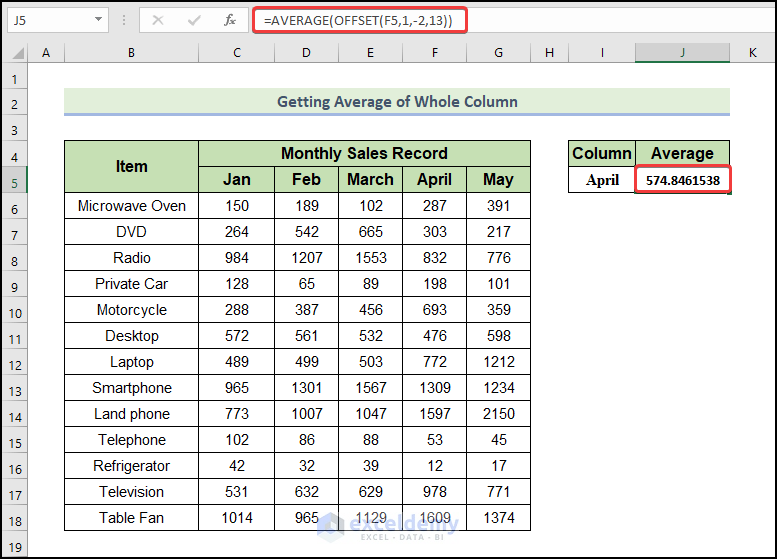
How Does the Formula Work?
- OFFSET(F5,1,-2,13)
The OFFSET function starts moving from cell F5. It moves 1 rows downward extracts the records of sales for the April column.
- AVERAGE(OFFSET(F5,1,-2,13))
We will use the AVERAGE function to average the output from the OFFSET function.
6 Suitable Examples of Offset Function with Excel VBA
Example 1 – Selecting a Range
Steps:
⧭ Open VBA Window:
- VBA has its own separate window to work with. You have to insert the code in this window. To open the VBA window, go to the Developer tab on your ribbon. Select Visual Basic from the Code group.

⧭ Insert Module:
- VBA modules hold the code in the Visual Basic Editor. It has a.bcf file extension. We can create or edit one through the VBA editor window. To insert a module for the code, go to the Insert tab on the VBA editor. Click on Module from the drop-down.
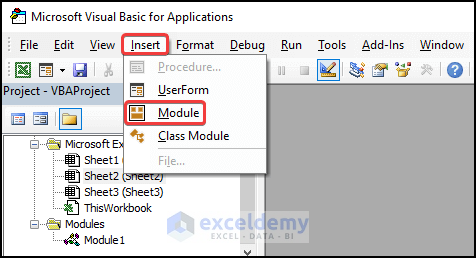
- A new module will be created.
⧭ Insert VBA Code:
- Select the module. Enter the following code in it.
Sub selectrangeoffset()
Range("A1:A6").Offset(4, 1).Select
End Sub- Save the code.
⧭ Run VBA Code:
- Close the Visual Basic window. Press Alt+F8.
- The Macro dialogue box will opens, select selectrangeoffset in the Macro name. Click on Run.
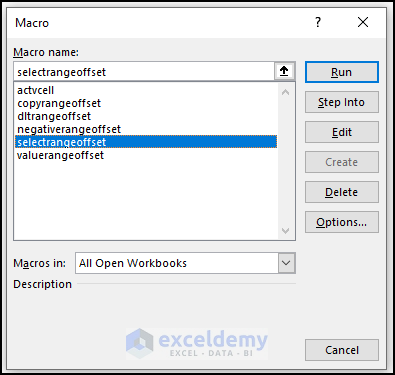
⧭ Output:
- You will get the following output.
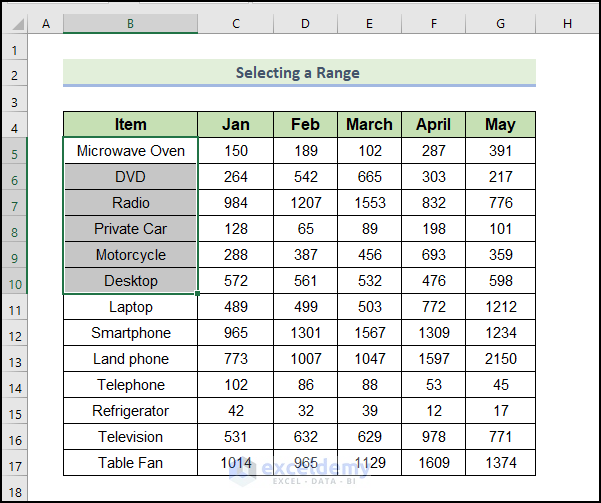
VBA Code Explanation:
Sub selectrangeoffset()Provide a name for the sub-procedure of the macro.
Range("A1:A6").Offset(4, 1).SelectRange(“A1:A6”) will select the range A1:A6, and Offset(4, 1) will move 4 rows downward from cell A1 and 1 column to the right side. The equal number of cells in the range A1:A6 will be selected.
End SubEnd the sub-procedure of the macro.
Example 2 – Using Negative Value in Offset Property
Steps:
⧭ Open VBA Window:
- VBA has its own separate window to work with. You have to insert the code in this window. To open the VBA window, go to the Developer tab on your ribbon. Select Visual Basic from the Code group.

⧭ Insert Module:
- VBA modules hold the code in the Visual Basic Editor. It has a .bcf file extension. We can create or edit one through the VBA editor window. To insert a module for the code, go to the Insert tab on the VBA editor. Click on Module from the drop-down.

- A new module will be created.
⧭ Insert VBA Code:
- Select the module. Enter the following code in it.
Sub negativerangeoffset()
Range("F11:F16").Offset(-6, -2).Select
End Sub- Save the code.
⧭ Run VBA Code:
- Close the Visual Basic window. Press Alt+F8.
- The Macro dialogue box will open, select negativerangeoffset in the Macro name. Click on Run.
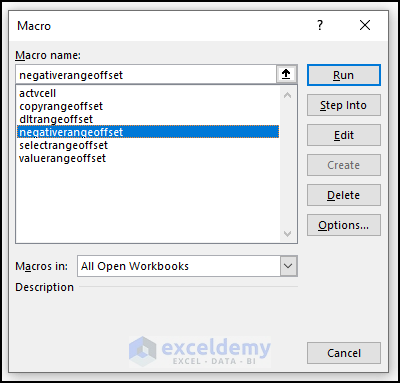
⧭ Output:
- You will get the following output.
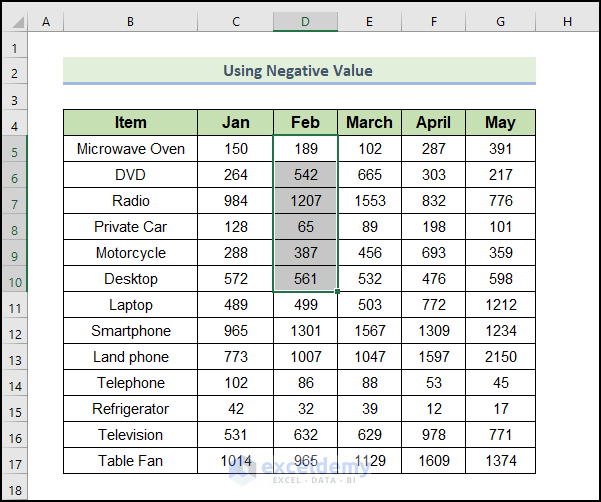
VBA Code Explanation:
Sub negativerangeoffset()Provide a name for the sub-procedure of the macro.
Range("F11:F16").Offset(-6, -2).SelectRange(“F11:F16”) will select the range F11:F16 and Offset(-6, -2) will move 6 rows upward from cell F11 and 2 columns to the left side. The equal number of cells in the range D5:D10 will be selected.
End SubEnd the sub-procedure of the macro.
Example 3 – Selecting a Range with Respect to Active Cell
Steps:
⧭ Open VBA Window:
- VBA has its own separate window to work with. You have to insert the code in this window. To open the VBA window, go to the Developer tab on your ribbon. Select Visual Basic from the Code group.

⧭ Insert Module:
- VBA modules hold the code in the Visual Basic Editor. It has a.bcf file extension. We can create or edit one through the VBA editor window. To insert a module for the code, go to the Insert tab on the VBA editor. Click on Module from the drop-down.

- Aa new module will be created.
⧭ Insert VBA Code:
- Select the module. Enter the following code in it.
Sub actvcell()
Range(activecell.Offset(4, 1), activecell.Offset(9, 3)).Select
End Sub- Save the code.
⧭ Run VBA Code:
- Close the Visual Basic window. Press Alt+F8.
- The Macro dialogue box will open, select actvcell in the Macro name. Click on Run.
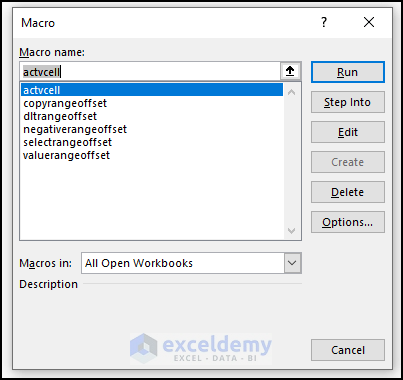
⧭ Output:
- You will get the following output.
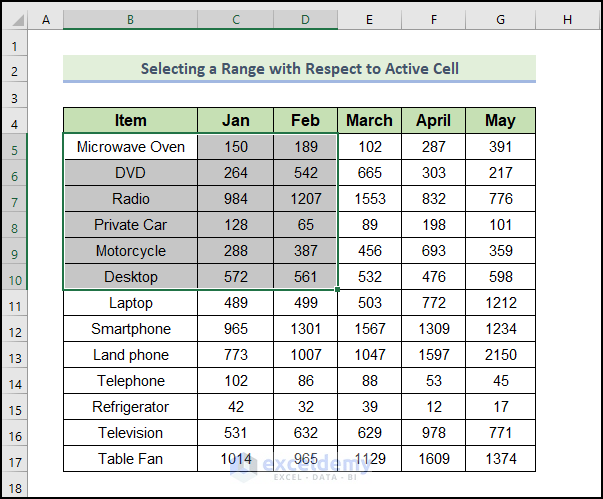
VBA Code Explanation:
Sub actvcell()provide a name for the sub-procedure of the macro.
Range(activecell.Offset(4, 1), activecell.Offset(9, 3)).SelectActivecell is A1. The first part activecell.Offset(4, 1) will select a cell 4 rows downward and 1 column right from the cell A1 and the second part activecell.Offset(9, 3) will select a cell 9 rows downward and 3 columns right from cell A1.
All of the cells between these two cells will be selected.
End SubEnd the sub-procedure of the macro.
Example 4 – Copying a Range
Steps:
⧭ Open VBA Window:
- VBA has its own separate window to work with. You have to insert the code in this window. To open the VBA window, go to the Developer tab on your ribbon. Select Visual Basic from the Code group.

⧭ Insert Module:
- VBA modules hold the code in the Visual Basic Editor. It has a.bcf file extension. We can create or edit one through the VBA editor window. To insert a module for the code, go to the Insert tab on the VBA editor. Click on Module from the drop-down.

- A new module will be created.
⧭ Insert VBA Code:
- Select the module. Enter the following code in it.
Sub copyrangeoffset()
Range("A1:A6").Offset(4, 1).Copy
End Sub- Save the code.
⧭ Run VBA Code:
- Close the Visual Basic window. Press Alt+F8.
- The Macro dialogue box will open, select copyrangeoffset in the Macro name. Click on Run.
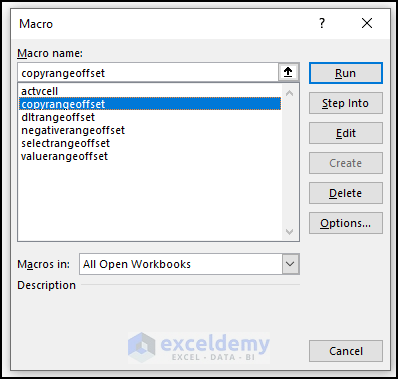
⧭ Output:
- You will get the following output.
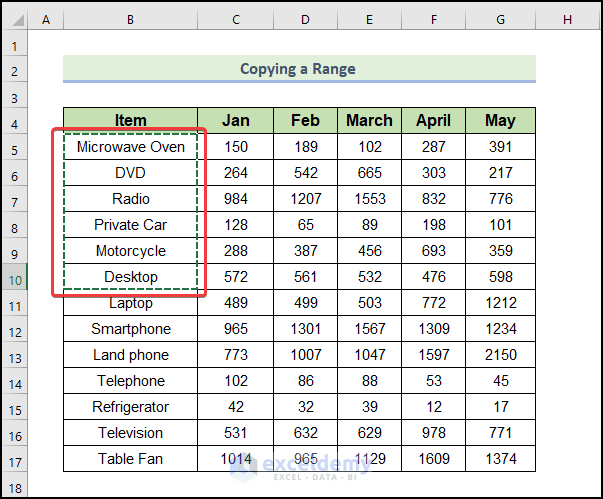
VBA Code Explanation:
Sub copyrangeoffset()Provide a name for the sub-procedure of the macro.
Range("A1:A6").Offset(4, 1).CopyRange(“A1:A6”) will select the range A1:A6, and Offset(4, 1) will move 4 rows downward from cell A1 and 1 column to the right side. The equal number of cells in the range B5:B10 will be selected.
It will copy the values in the range B5:B10.
End SubEnd the sub-procedure of the macro.
Example 5 – Deleting a Range
Steps:
⧭ Open VBA Window:
- VBA has its own separate window to work with. You have to insert the code in this window. To open the VBA window, go to the Developer tab on your ribbon. Select Visual Basic from the Code group.

⧭ Insert Module:
- VBA modules hold the code in the Visual Basic Editor. It has a.bcf file extension. We can create or edit one through the VBA editor window. To insert a module for the code, go to the Insert tab on the VBA editor. Click on Module from the drop-down.

- A new module will be created.
⧭ Insert VBA Code:
- Select the module. Enter the following code in it.
Sub dltrangeoffset()
Range("F11:F17").Offset(-7, -2).Delete
End Sub- Save the code.
⧭ Run VBA Code:
- Close the Visual Basic window. Press Alt+F8.
- The Macro dialogue box will open, select dltrangeoffset in the Macro name. Click on Run.
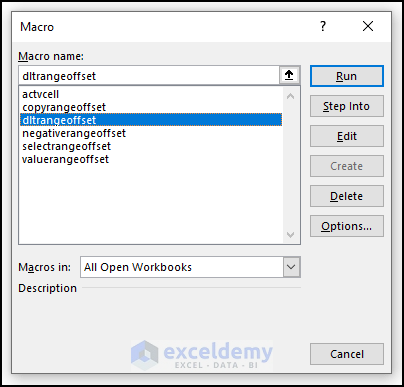
⧭ Output:
- You will get the following output.
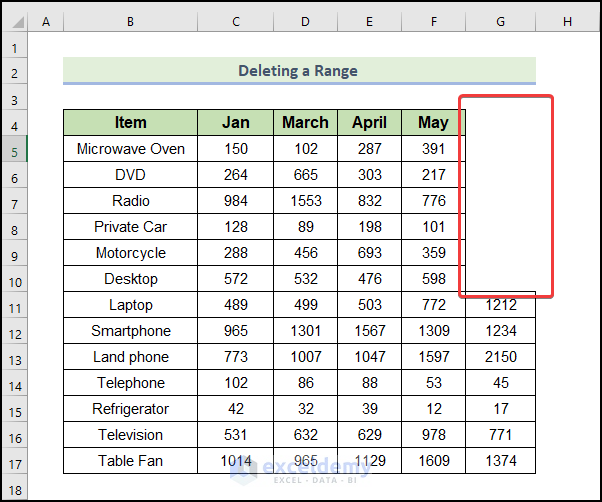
VBA Code Explanation:
Sub dltrangeoffset()Provide a name for the sub-procedure of the macro.
Range("F11:F17").Offset(-7, -2).DeleteRange(“F11:F17”) will select the range F11:F17, and Offset(-7, -2) will move 7 rows upward from cell F11 and 2 columns to the left side. The equal number of cells in the range G4:G10 will be selected.
It will delete the range G4:G10.
End SubEnd the sub-procedure of the macro.
Example 6 – Entering Value to a Cell
Steps:
⧭ Open VBA Window:
- VBA has its own separate window to work with. You have to insert the code in this window. To open the VBA window, go to the Developer tab on your ribbon. Select Visual Basic from the Code group.

⧭ Insert Module:
- VBA modules hold the code in the Visual Basic Editor. It has a.bcf file extension. We can create or edit one through the VBA editor window. To insert a module for the code, go to the Insert tab on the VBA editor. Click on Module from the drop-down.

- A new module will be created.
⧭ Insert VBA Code:
- Select the module if it isn’t already selected. Enter the following code in it.
Sub valuerangeoffset()
Range("A1").Offset(6, 1).Value = "Laptop"
End Sub- Save the code.
⧭ Run VBA Code:
- Close the Visual Basic window. Press Alt+F8.
- The Macro dialogue box will open, select valuerangeoffset in the Macro name. Click on Run.
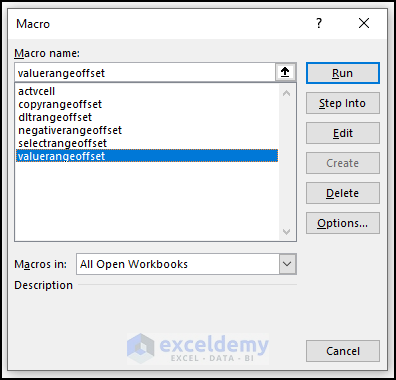
⧭ Output:
- You will get the following output.
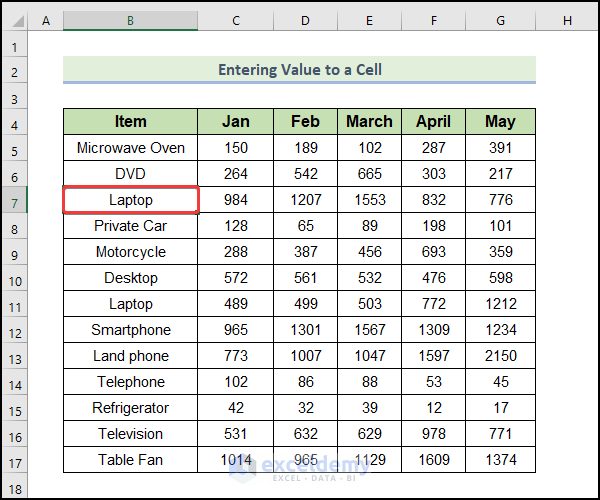
VBA Code Explanation:
Sub valuerangeoffset()Provide a name for the sub-procedure of the macro.
Range("A1").Offset(6, 1).Value = "Laptop"Range(“A1”) will select the cell A1, and Offset(6, 1) will move 6 rows downward from cell A1 and 1 column to the right side. Cell B7 will be selected and it will enter the value “Laptop” in this cell.
End SubEnd the sub-procedure of the macro.
Further Readings
- How to Use INDIRECT Function in Excel (12 Suitable Instances)
- Find text in an Excel range & return cell reference (3 ways)
- Excel Reference Cell in Another Sheet Dynamically


